If you’re a content writer, digital marketer, or a website owner who is just getting started with his content marketing strategy, chances are you’ve been asking yourself, “How do I know what to write about?”
Starting with researching keywords is important, especially if they’re relevant to your site’s niche.
However, keyword research isn’t just about coming up with keywords.
Rather, it’s also an opportunity to find new ways to talk about what your target audience cares about.
A good strategy for identifying these topics is to conduct a content gap analysis.
With content gap analysis, you’ll drive more SEO traffic, convert more leads, add substantial value to your target audience, and increase your search visibility.
We’ll be discussing what content gap analysis is and how you can use it to evaluate and improve your own website’s content.
So let’s dive in!
What Content Gap Analysis Exactly Means
It is a process in which you evaluate your existing content on a topic and identify any existing gaps.
These gaps are topics that you haven’t yet covered or areas where your current piece of content is lacking.
In order to improve your website’s content and organic traffic, you need to fill these gaps with new or better content.
It can help you improve your strategy by identifying these gaps and providing direction on how to fill them.
Content gap analysis comes after your keyword research. You should already have an idea about the keywords you want to rank for.
Next, find out the type of content produced around those keywords.
You can then compare this information against your list of keywords and see what gaps exist.
The best part is that this method helps you identify the types of content that you may not have considered before.
Imagine your initial plan is to focus on creating blog posts around a specific search query.
But after conducting a content gap analysis, you see that your audience is seeking video content around that keyword. The optimal solution here would be to produce a video instead.
The same goes for images, infographics, eBooks, and any other content format.
It’s all about finding the right balance between different content types so that you don’t end up spreading yourself too thin.
What Makes Content Gap Analysis Significant?
Content analysis allows you to take a step back and look at your website from a bird’s eye view.
It can be easy to get bogged down in the day-to-day details of creating and managing content.
But it can help you audit your content to identify areas of improvement as you evaluate your overall strategy.
It can also help to improve your website’s SEO. By identifying gaps in your content, you can make sure that you are covering all the relevant keywords and topics for your audience.
This will help your website to rank higher in search engine results pages (SERPs), making it more visible to potential customers.
Common Content Gaps Include
- Content freshness: Is this piece of content recently created or updated?
- Comprehensiveness: Does this piece of content include all information that covers this topic?
- Usability: Is it easy to read and understand what’s on the page?
- Wow factor: Is this piece of content impressive enough to share with others?
How to Do a Content Gap Analysis?
1. Lay Out Your Customer’s Journey
The first step is to identify your buyer’s journey. This means understanding the different stages that a potential customer goes through when they’re considering a purchase.
There are typically three stages to any buyer’s journey:
- Awareness: It’s the “aha!” moment – the awareness stage when a potential client realizes they’ve been missing out on something great or need a little help to solve a problem.
- Consideration: This is the “Let me see what my options are” stage during which a potential customer begins to look for available solutions for their problem.
- Decision: The moment of truth has arrived – our buyer persona has reached the decision stage, and is poised to make their final move towards a purchase!
For each stage of the buyer’s journey, you need to identify:
- The content that already exists on your website.
- The gaps within that content.
To do this, you can use a spreadsheet to track your content and make notes on where gaps exist.
Here is an example of how you can do it:
| Buyer’s Journey | Existing Content | Content Gap |
| Awareness | Blog post on problem-solving | eBook on problem-solving |
| Consideration | Case study on the product | Video testimonials from customers |
| Decision | Product page | FAQ section |
Another example can be:
| Buyer’s Journey | Existing Content | Content Gap |
| Awareness | Educational content | Guides |
| Consideration | Podcast | Webinar |
| Decision | Live Demo | Products Comparison |
As you can see, a successful content gap analysis provides a way to quickly identify where your content is lacking and what needs to be created.
By mapping out your buyer’s journey, you can make sure that you are providing the right content for each stage to drive them to their decision-making process.
2. Audit Your Content
One important step is to do a web content audit, which just means making a list of topics you already have on your website.
By checking out things like which pages are popular and which ones aren’t, you can figure out where there might be some gaps in your content.
And using tools like Google Search Console can help you see which keywords your site is ranking for (and which ones it’s missing out on!).
By analyzing your current content like this, you’ll be able to identify your underperforming content pieces.
And with that knowledge, you can come up with a solid plan to improve your content strategy and make sure you’re giving your audience the right info.
Doing all this will help you create an effective strategy and get your website seen by more people on those all-important search engine results pages!
If you want to learn more about conducting a SEO content audit, be sure to check out our article!
3. Do Content Marketing Research
In addition to mapping out your buyer’s journey, you must do market research to understand what content exists on your topic.
You can do content marketing research by searching for your target keyword on Google and taking notes of the results that show up for you.
You should also look at what your competitors are creating.
What do they do in their high-performing content? Are there any gaps in their content?
Your market research should answer the following questions:
- What pieces of content exist on your topic?
- What are you missing in your topic?
- What can you improve in your content?
Once you’re done with your market research, you can use this information to create a plan for filling the gaps.
This plan should include the content you want to create and when you want to publish them.
4. Analyze Competitors’ Content
It’s not just enough to research the market and check out your own content. You should also snoop on what your competitors are up to.
Check out their website’s analytics to see which pages are doing great and which ones are tanking.
You can also use Google Search Console to find out which keywords they’re ranking for and which ones they’re missing out on.
By taking time for some competitor analysis, you can come up with a plan to make your own content strategy even better.
5. Fill Any Gaps
Once you have done your research, it’s time to fill any gaps that you may have discovered.
Create new content or improve the existing ones. If you’re not sure where to start, consider hiring a professional content writer or digital marketing agency to help you with this process.
What tools are used for content gap analysis?
There are a bunch of SEO tools out there that you can use to do content gap analysis.
Some of the popular ones include SEMrush, Ahrefs, and Frase.oi.
When you’re using SEMrush or Ahrefs to find competitors, look for domains that come up a lot in their keyword research tools. These are likely to be your main competitors.
You can unlock the secrets of your competitor’s top pages! Discover how they attract the most visitors and filter by advanced metrics to uncover the ultimate digital strategy.
If you are struggling with keyword research, Google provides helpful tools such as the Free Google Keywords Planner and Google Trends to gain insight into the demand and history of keywords related to any topic.
If you want to make a really complete list of competitive keywords, you might need to do some manual research. That means looking at the top results for the keywords you’re interested in and noting down which domains come up a lot.
You can also use some other tools like Google’s Search Console, KeywordTool.io, or AnswerThePublic to get more keyword opportunities, content, or subtopics.
And if all else fails, you can check out the Google AdWords Auction Insights report to see what your competitors are up to and get some inspiration for your own content strategy.
1. Using Ahrefs to Do a Content Gap Analysis
One of the coolest things about Ahrefs is that it can help you to understand your competitor’s content strategies by providing you with insights into the keywords they are ranking for, the backlinks they have earned, and the content they are publishing.
Begin by navigating to the “Site Explorer” section in Ahrefs and entering your website’s domain.

You might have noticed that the user in this example is using a prefix like “blog” because their blog content is attached to a subdomain. However, if your blog is connected to a root domain, you can simply use the main domain without any prefixes.
After that, go ahead and click on the search button.
Now, direct your attention to the menu tab on the left side and give it a friendly click.
Look for the option called “Content Gap” and select it.

On the Content Gap page, you can enter the domains of your competitors. We added three competitors as an example.

Pro Tip: If you’re unsure about who your competitors are, you can use the Competing Domains feature, which you can find on the left-hand menu tab in Ahrefs.
Just before you click on the “Show keywords” button, take a moment to check out the “Show Keywords” filter. It’s important to select the options that best suit your needs.
You can choose to search for keywords that any of your competitors have or only focus on the keywords they have in common.
Pro Tip: The Ahrefs tool is designed to provide you with results by analyzing the top 100 entries related to your topic. If you want to refine your search, remember to select the option “At least one of the targets should be in the top 10.” This will help you narrow down the results even further.

Once you click on it, a new page will appear, displaying a comprehensive list of keywords that your competitors are ranking for, but you aren’t.
On the right side of the page, you’ll find the three competitors listed under the title “Highest position.”
As you can see, there are more than 47.000 identified keywords in the list.

Now, Take a closer look and make note of the keywords you currently use to rank on Google.
You can use these keywords in your own blog posts for better optimization.
Another awesome feature in Ahrefs that can assist you with conducting gap analysis is “Organic Keywords.” This feature allows you to enter your domain or prefix and gain a clearer picture of your rankings on search engine results pages (SERPs) for various keywords.
It helps you identify which content requires updates by understanding your current position.

2. Using SEMRush to Perform a Content Gap Analysis
Semrush is another fantastic tool you can use to perform gap analysis. It helps you analyze both keywords and backlinks, giving you valuable insights.
Keyword Gap
Keyword Gap provides a convenient side-by-side comparison of keyword profiles for up to five competitors.
Let’s get started! Just enter the names of the domains you want to compare.
If you’re not sure who your top competitors are, you can use the Organic Research Competitors report or Advertising Research Competitors to find domains with similar keyword rankings.
Once you enter your domain name, the tool will automatically suggest some top competitors in the drop-down menu below the competitor fields.
If you want to compare keywords on a more specific level, you can also specify an exact URL, subdomain, or subfolder in one of these fields.

Once you have entered the domains for comparison, you can select the “keyword type” you want to analyze. This refers to the type of search engine results you are interested in.
- Organic keywords are those where a domain has a natural ranking within the top 100 search results.
- Paid keywords are keywords where the domain is ranking through Google Ads in the top 8 positions on Google.
- PLA keywords are keywords that trigger the domain’s product listing ads, which are paid for through Google Shopping.
If you click on “select keyword type for each domain,” you can choose to compare different types of keywords between the sites.

Afterward, the report will populate information into the Top Opportunities widget, Keyword Overlap chart, and the keyword table at the bottom.

The Top Opportunities widget gives you a sneak peek of the most valuable keyword opportunities for your website (labeled as “You”), based on the domain you entered in the first field.
The keyword overlap visualization helps you see how much overlap there is in the keyword portfolios of your competitors.
Pro tip: Keep in mind that the information provided in the entire report will adapt according to any filters you apply.
The report includes a table at the bottom, which provides details about each website’s keyword profile in relation to their competitors. The intersection types are:
- Shared: Keywords where every site has a ranking.
- Missing: Keywords where competitors have rankings, but your site doesn’t.
- Weak: Keywords where your ranking is lower than all competitors.
- Strong: Keywords where your ranking is higher than all competitors.
- Untapped: Keywords where competitors have rankings, but you don’t.
- Unique: Keywords where you have a ranking, but competitors don’t.
- All keywords: The combined list of all keyword rankings among competitors.

Once you have all this information, export the data to Google Sheets and filter through to find valuable keywords that are relevant to your business, but you don’t currently have content for.
Backlink Gap
With the Backlink Gap tool, you have the opportunity to compare the backlink profiles of up to five competing websites simultaneously.
Simply enter the domains, and Semrush will provide a list of referring domains that are sending links to these sites. By using filters, you can easily spot the websites that are linking to your competitors but not to you.
This tool assists SEOs in identifying gaps in competitors’ link-building strategies, allowing them to plan their own outreach and build valuable links.
When using the tool, you’ll see a graph and a table that showcase the comparison of backlink profiles among competitors. To get a quick overview of which competitor is acquiring the most backlinks, take a look at this trend graph.

Directly below the graph, you’ll find a table that lists all the referring domains that send backlinks to the websites you’ve entered. This valuable information is gathered from SEMrush Backlink Analytics.

3. Using Frase.io to Identify Content Gaps
Frase Content Analytics is a great tool for identifying content gaps. It provides insights about ranked pages on your site and which queries drive traffic to these pages.
It gives you an idea of what kind of content you should create to address these gaps.
3.1. Auditing Your Content
To use Frase.io to conduct a content gap analysis, choose one of the ranking pages that have a low position.
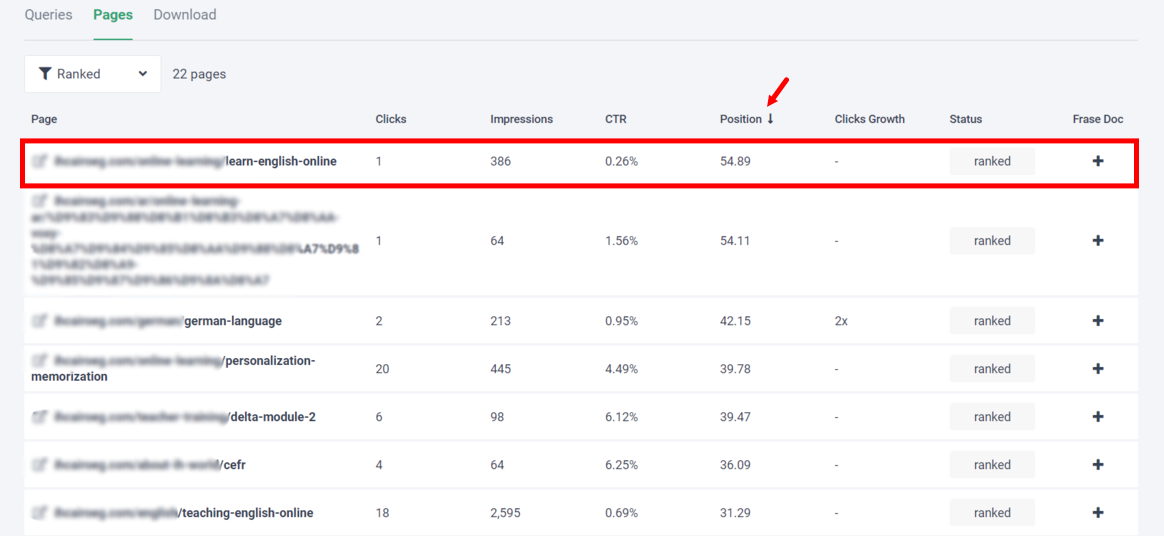
Then, click on its link to check the queries that the page ranks for.
Now, set your impressions status to “descending order” to sort from highest to lowest amounts of impressions on Google.
The query “Limited Company Tax” has 435 impressions, a position valued at 37.46, and zero clicks.

To analyze the page for this query against the top results, tick the box next to the query and the “+” sign at the end of the row.
Next, click on “Create Doc”.

Review your input information then press “Save and continue”.

Now, click on the “Frase Doc” link.

Review the copy and press “Confirm Import”.
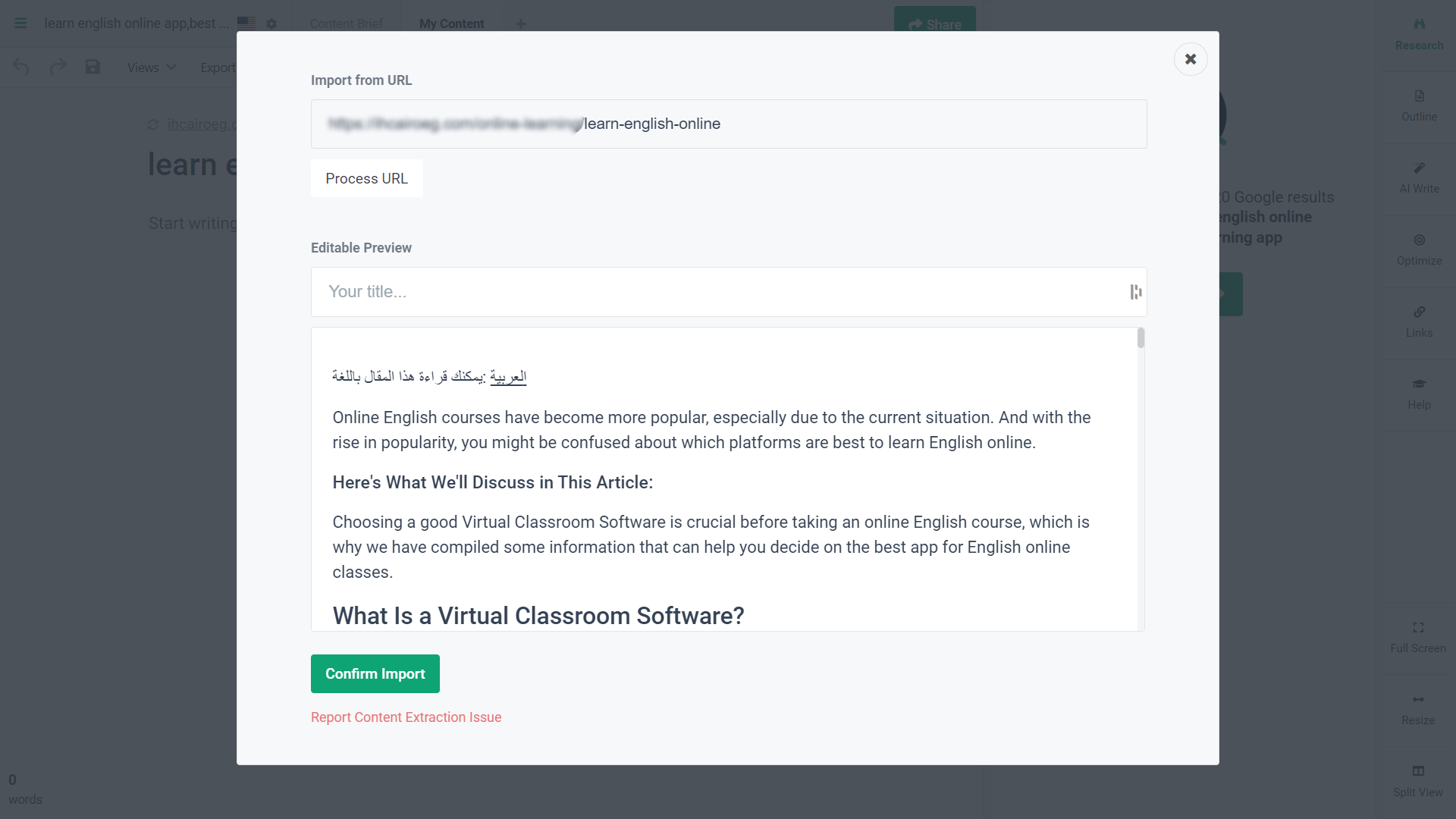
3.2. Determining Content Gaps
Now that we’ve imported this webpage, let’s compare its performance against top-ranking competitors.
Click the “SERP” tab then the pencil icon next to “results processed.”

Select the top 10 links and save.

Now click the “Optimize” tab.
Compare your “Topic Score” with the average topic score of your competitors.

If you want to determine if you have any gaps in fulfilling the search intent, review competing page titles.
Select “All Scores” in the “Optimize” tab.
Compare your article’s title to those of your competitors.
Judging from our competitors’ headlines, we’re focusing on the same topic.
Therefore, it’s safe to say that we’ve addressed the search intent.
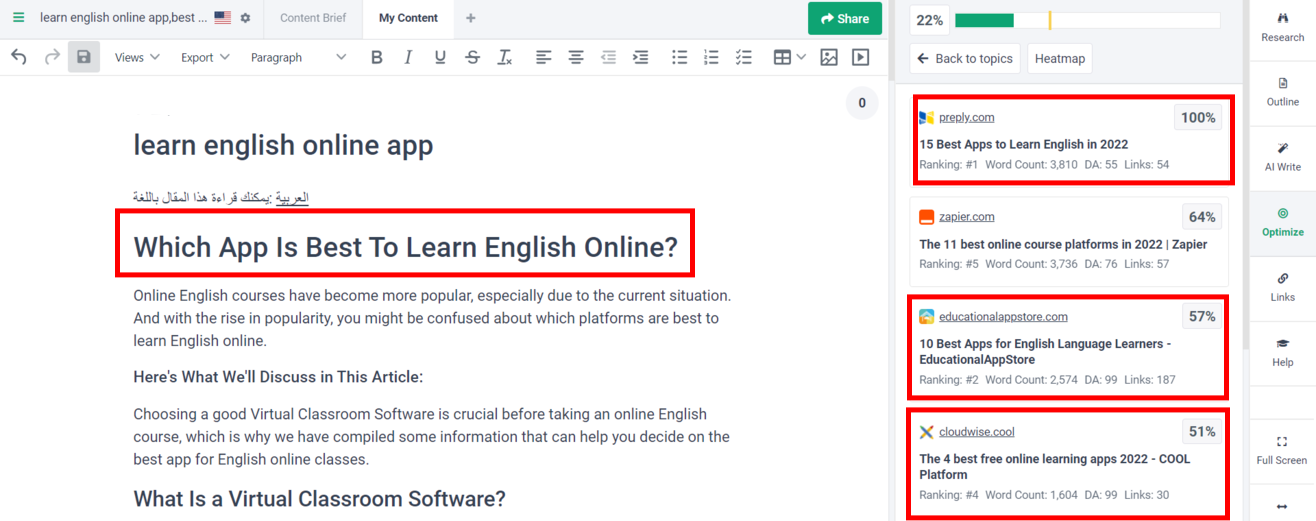
Now comes your time to read through your article to see if it still makes sense today as it did when you first published it.
For example, this webpage tackles online English-learning apps. So is the information covered here still the most up-to-date information on the web?
3.3. Identifying Word Count Gap
From the “Research” tab, Frase.io automatically calculates the document’s average word count against the average word count of its top results.
While word count is not a ranking factor, if there’s a significant difference, perhaps the page you’re reviewing has content gaps.

3.4. Discovering Header Gaps
Select “Headers” and then “Topic Gap” from the “Optimize” tab.
You’ll find a gray-tiled list of several headings that appear on the top-ranking pages but don’t exist in your content.
If you hover over any gray tile, you’ll see the prompt about headers.
Adding some of these headings to your page will boost your topic score.

3.5. Long-Tail Gap
From the “Optimize tab”, select “Long Tail” and then “Topic Gap”.
You will see a list of ranking phrases that don’t appear on your page.
Cover the topic in more depth by adding the recommended long-tail keywords to your content.

3.6. Question Gap
There are two ways to find question gaps in your content:
- Finding questions that serve as main sections of your competitors’ articles.
- Finding questions that serve as complementary points to the articles, such as FAQs.
Let’s go through both of them, one by one.
To find gaps in the former way, go to the “Research” tab and select “Headings” from the “SERP Overview” drop-down menu.
For example, one of our top-ranking competitors covers the main topic of English-learning web apps using the question: “What Is an E-Learning Web App?”
Our page covers this idea using the heading: “What Is a Virtual Classroom Software?”
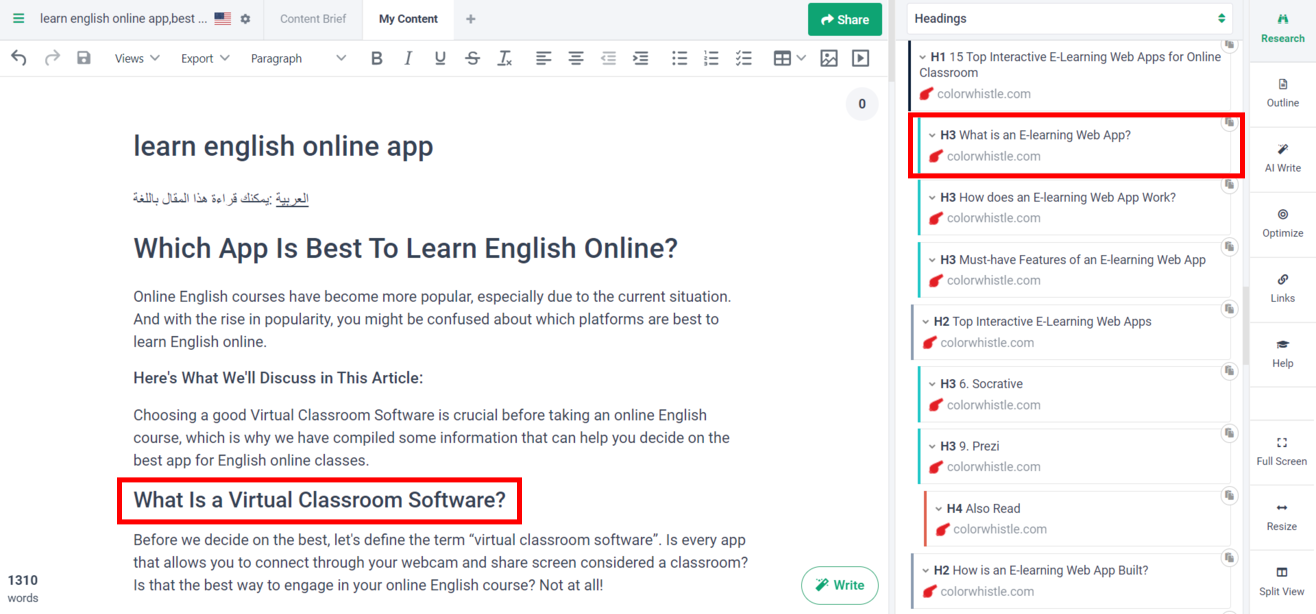
As part of the content audit, we’ve covered the search intent.
However, since we’re refreshing our content, we can rephrase the question to add one of our targeted keywords (i.e., “online learning app”).
Now, the latter way is to go to the “Research” tab and then click the “SERP Overview” drop-down menu.
Next, click on “Questions” to view the list of questions that your competitors are targeting.
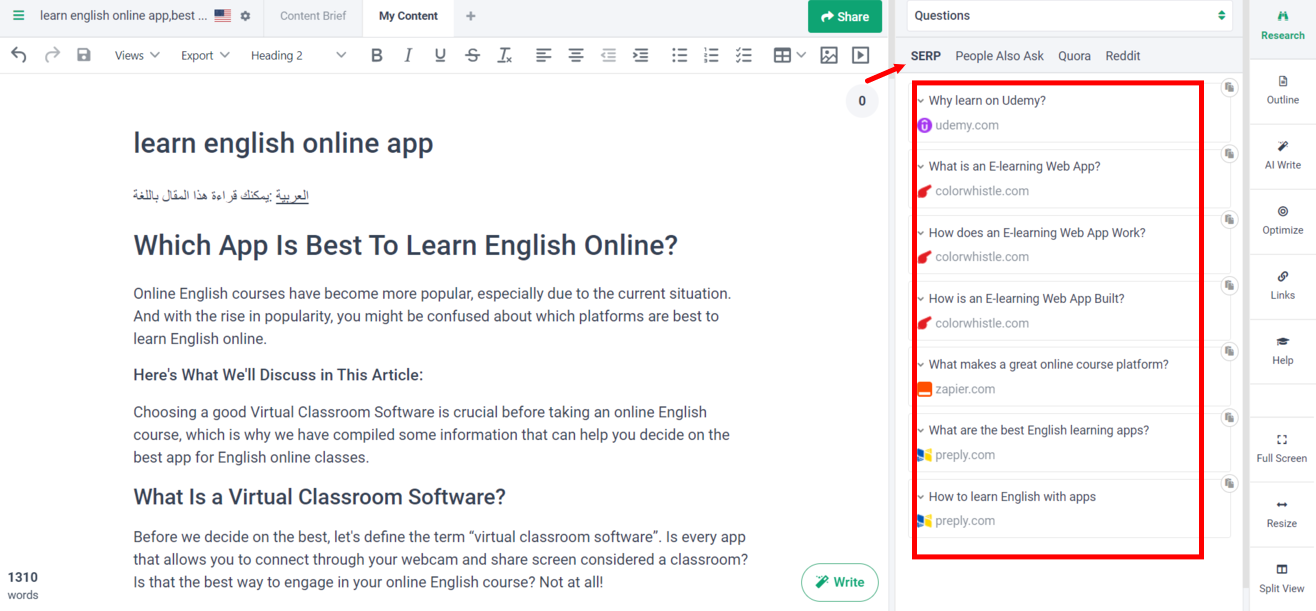
Keep in mind that the SERP option shows you all the questions covered by your competitors whether they serve as main topics or complementary points.
To view the rest of the questions that your competitors might have missed, look at what your audience is asking using other options like “People Also Ask,” “Quora,” and “Reddit.”

Making changes to your overall content strategy based on the results you’ve found will make your content much more effective.
How to Add the Results of Your Content Gap Analysis to Your Topic Clusters
Topic clusters are sub-topics branching from a central main topic that serves as a big umbrella (also known as the “pillar page”).
Topic clusters and pillar pages offer back-and-forth internal linking opportunities to keep readers on your site.
Let’s say you’re a digital marketing agency that offers search engine optimization solutions. After doing your content gap analysis, you find a topic called “content creation process”. This topic then becomes a topic cluster for your pillar page called “SEO”.

Or imagine you’re an online fitness store. After doing your content gap analysis, you come across a topic named “workout routines to get abs”. This topic then becomes one of your topic clusters for your pillar page “workout routines”.

Getting Your Content Gap Analysis Right
Effective gap analysis is an important step in any good online marketing strategy. It helps ensure that you’re providing the right kind of info for your target audience.
By conducting market research and analyzing your existing content, you’ll make sure your strategy works and improves your site’s ranking in search engines.
Frequently Asked Questions (FAQs)
Keyword research is a method used to identify keywords or phrases that people type into search engines like Google or Bing. It helps you determine what people are searching for so that you can write content that answers these questions.
A content audit is the process of cataloging and analyzing all of the content on your website, including its performance, and then making any changes necessary to improve it.
Content marketing is a type of marketing strategy used to attract and engage audiences by creating and sharing relevant content. This approach helps establish expertise, promote brand awareness, and keep your business at the top of your audience’s mind whenever it’s time to take action.
A topic cluster refers to a group of related topics that revolve around one main topic and use a pillar page to link back and forth between them.
Put differently, topic clusters are centered around a single topic and offer multiple internal linking opportunities to keep readers on your site.
A pillar page is a webpage that covers the overall topic thoroughly and links to topic clusters that contain related content.




